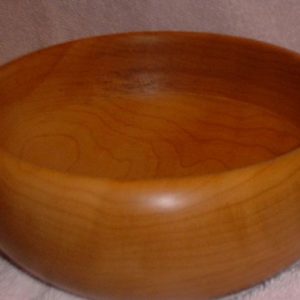I have seen the small sanders for the Lathe- the handle with the disk that’s on a bearing with the stick on paper. Is this what I need to sand the inside of bowls?
I made a bowl out of hard maple the only way I had to sand the inside was to hold paper by hand .
I gave up trying to get all the end grain tear out sanded out after 1 hour.
Thanks Ron
















Replies
Ron -
Which tool did you use for the finishing cuts on the inside? Scraper or gouge?
Please don't take this the wrong way but .... your tools have to be exceedingly sharp, your cuts have to be very very fine and your patience infinite to tame endgrain. I've resorted to hand sanding with 120 with the lathe stationary, sanding with the grain as though the piece were a piece of flat work. Then after getting it quite smooth, spinning it back up and going to the finer grits.
There are a few turners here that have far more experience than I do that may offer better suggestions, but my first impression is you may need to spend more time at the sharpening bench and use a lighter hand.
Dennis in Bellevue WA
woodnut@anatechsys.com
Could be the problem Dennis & I'm not a bowl turner
About all I have done is spindle turning
I used a scraper - It seemed to be sharp I was getting nice long peelings and I was hogging off a lot of wood. I guess I did not leave enough to lightly scrape out the tear out
Have you not seen the little sander I'm talking about? I was hoping someone had one and would tell me about it.
I use my orbital sander on turnings with out turning on the sander- just letting the revolving wood spin the sander and it works very well- I just thought the small sander that I was referring to would be handy for inside of bowls
Edited 7/26/2003 10:43:44 AM ET by Ron
Dennis I finally found the little sander I had seen
INERTIA SANDER
Developed by Australian woodturner Vic Wood, the Inertia Sander is a very simple sanding device that eliminates heat build that can cause checking and premature wear on sanding discs. It consists of a 6" cylindrical plastic handle with a 3" diameter velcro disc holder mounted in a ball bearing which is located in the handle. As the sanding disc comes in contact with the workpiece, it begins to spin creating the sanding action. By contacting the work with the outer edge of the disc, it will spin faster. Sanding near the center of the disc will result in a slower speed sanding action. The sander accepts all types of hook and loop sanding discs and includes 10 assorted discs.
Ron-- try wetting the wood before taking a LIGHT final cut with a sharp scraper. This sometimes helps with end grain tear-out. What grit paper did you start with? On maple with its tight hard grain, you might need to start with a pretty coarse grit ( 50 or 60 ) and go up to 400 or 600, or even higher if you really like to sand.<G>
Hi Ron -
Yes, I've seen these little sanding tools. Don't have one and haven't used one so can't offer any comments on them. What I'm trying to do with my lathe technique is to reduce the amount of sanding as much as possible. My ultimat goal is to produce a piece finished off the tool. I'm miles from it yet - can't even see the end of the tunnel. But .... practice, practice, with sharpening inbetween at frequent intervals. The lighter hand I use with the sharpest I can get my tools seems to produce the best finish.
Oh - just thought of another thing -
Can you reverse your lathe? Try sanding or even extremely light scraper cuts with the piece running 'backwards. Obviously you have to cut on the other side, but with very light cuts you can sometimes scrape off those fibers that are pointing in the "other" direction.
...........
Dennis in Bellevue WA
woodnut@anatechsys.com
Looks like your bowl has fairly steep sides and a flat bottom. The first thing I would suggest is shear scraping. Use a round-nose scraper. From flat on the toolrest, twist the tool 45 degrees counter-clockwise so it's resting on one corner. Engage it near the bottom of the side and pull towards the rim. Don't get too close to the bottom - engaging the bottom and the side at the same time earns you a major catch! Run the lathe slow and take it easy - you want dust and tiny fluffy shavings that blow away. Expect to spend 15 minutes doing this.
On the sander, I don't have an inertial sander and most of what I've read by people who have has been lukewarm - they work OK but take getting used to and work slowly. I use a disc pad on an electric drill for most sanding but the best thing I've found for the inside of bowls is an inflatable bowl sander from Woodworkers Supply http://woodworker.com/cgi-bin/FULLPRES.exe?PARTNUM=114-965
It works very well on the sides and does inside hollow forms as well.
HTH
Graeme
This forum post is now archived. Commenting has been disabled